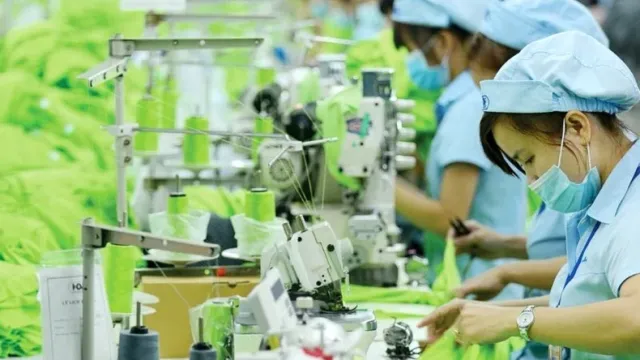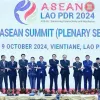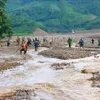Green export: Change or exit the "game"?

Enterprises proactively change
As a textile and garment enterprise mainly operating in the export sector, many years ago, Phong Phu Joint Stock Company proactively changed the robot technology line and implemented control of technical requirements for orders for the two EU and US markets. A series of processes were adjusted, such as strict management of consuming electricity, water, emissions, and wastewater; developing a plan to reduce energy and chemical consumption; and gradually replacing old equipment, creating a good working environment for workers. This not only helps Phong Phu textile and garment meet standards and enhance its reputation with partners but also increases the competitiveness of its products, attracting more orders, especially from premium brands.
Another exporting company, Sao Ta Foods Joint Stock Company, is also implementing solutions to promote green exports. Dr Ho Quoc Luc, Chairman of the Board of Directors of Sao Ta Food, shared that the company has been expanding sustainable aquaculture models and upgrading value chains in its aquaculture feed system. Thanks to good aquaculture zoning, production by value chains, and control over all stages of production and processing, the company meets all quality, food safety, and quarantine requirements from the EU.
The global trend of consumers choosing seafood for health benefits also demands that businesses move towards green production, using controlled aquaculture while reducing exploitation to ensure sustainable development. This presents both challenges and opportunities for Vietnamese seafood companies.
The rapid shift by businesses toward green production and export methods has enabled them to meet market demands, particularly in major export markets.
Nguyen Cam Trang, Deputy Director of the Import-Export Department of the Ministry of Industry and Trade (MoIT), said that green production, green economy, and circular economy are inevitable trends. Each country has its own plans and timelines to implement these activities. In reality, the green regulations of importing countries allow time for exporting countries like Vietnam to gradually adapt rather than imposing immediate requirements.
"Vietnamese businesses have already shown awareness, and many have proactively implemented measures to meet these regulations. However, we are still facing many difficulties and limitations in adapting," shared Trang.
Agreeing with this, Le Quoc Phuong, former Deputy Director of the MoIT’s Industry and Trade Information Centre, noted that Vietnam has joined 16 Free Trade Agreements (FTAs), many of which include green requirements. For example, the FTA with the EU contains regulations on carbon evaluation, emissions during production, and green export strategies. However, many businesses are still unaware of these.
Moreover, some businesses, though aware, view green transformation as a challenge and reluctantly comply due to limited financial resources. This is a key reason why green transformation, production, and export in Vietnam have been slow and challenging.
Phan Thi Thanh Xuan, Vice President and Secretary General of the Vietnam Leather, Footwear, and Handbag Association, shared that meeting green standards is a gradual process because it involves significant technology investment.
For instance, businesses must switch to clean energy or replace fuel sources like coal in factories. These are requirements that demand substantial resources. Nonetheless, businesses understand that if they do not adapt, they will lose orders. Companies that have sustained and developed to this point are those that have invested in green standards, while those unable to adapt will gradually be eliminated from the market.
Promoting green export businesses
Dr Nguyen Thị Thu Trang, Director of the WTO and Integration Centre under the Vietnam Chamber of Commerce and Industry (VCCI), believes that transitioning to green production and export requires significant capital investment and advanced technology, which not all businesses can pursue and meet. However, this is an irreversible trend, and to avoid being excluded from the "game" by the high environmental and social standards set by import markets, Vietnamese businesses need more support from ministries, sectors, and local authorities in terms of mechanisms and policies.
 |
Increasing green production and exports is an irreversible trend. |
To help Vietnamese export businesses quickly meet green standards, the Ministry of Industry and Trade focuses on shifting business mindset, raising awareness of green supply chains, and aiming to turn Vietnam into a "green factory" of the world.
Minister of Industry and Trade Nguyen Hong Dien stated that in the near future, the Ministry will implement international cooperation programmes to help businesses select the most suitable certifications or standards for each market and product target. This will allow businesses to minimise compliance costs and enhance their product and business competitiveness.
At the same time, to avoid violations of regulations in importing countries, businesses need to prepare and research market conditions, particularly technical measures specific to each market, to ensure full compliance before exporting. The Ministry has instructed the Vietnam Trade Office network abroad to support businesses in promoting their efforts to adapt to and meet green standards set by other countries.
Guidelines, handbooks, and information related to foreign regulations will also be provided to associations and businesses promptly, helping them to proactively plan production and business operations in line with market demands.
The Ministry will also collaborate with industry associations to conduct training on product models, branding, and design to ensure that export products can sustainably grow in global markets.
Tags:





